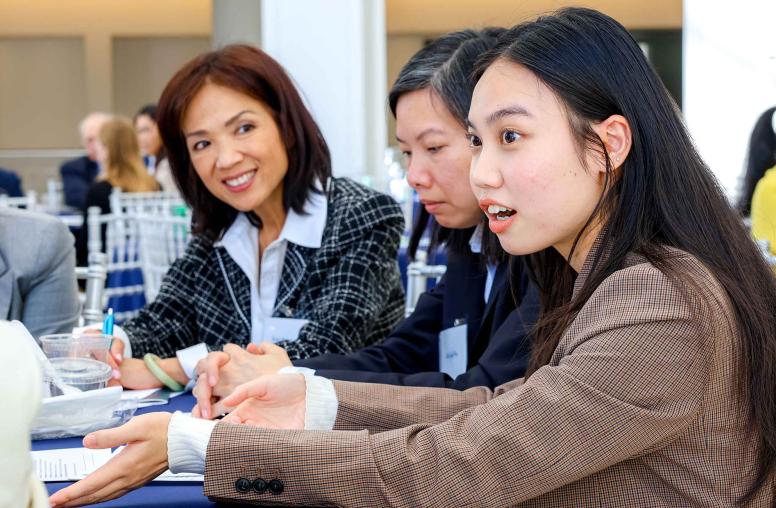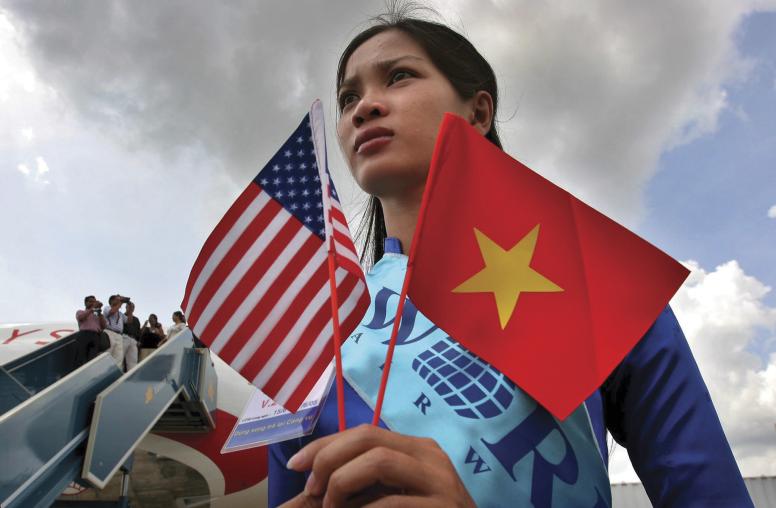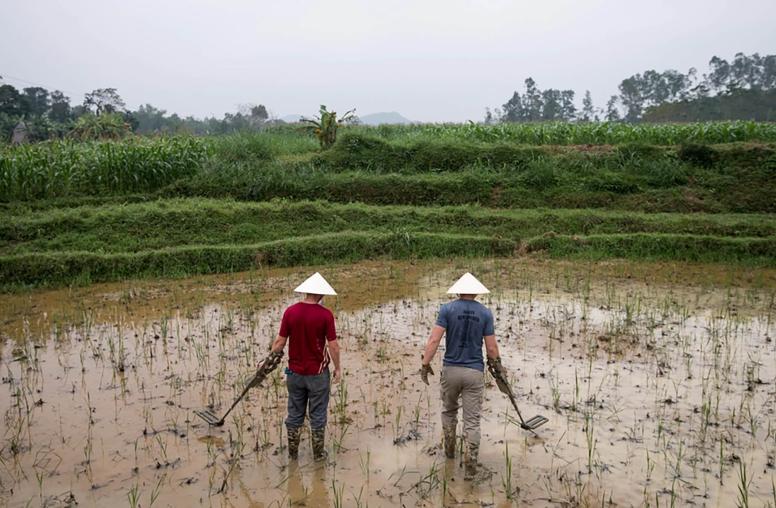Policy of Diversification Helps Vietnam Build Ties with the Indo-Pacific
Long-standing tradition enables Hanoi to navigate great-power competition and adapt to shifting geopolitics.
Vietnam’s leaders have engaged with the presidents of the United States and China over the past few months. While some might see this effort as a “balancing act” in response to U.S.-China competition, it is, in fact, an indication of a long-standing but still highly relevant Vietnamese foreign policy tradition: the diversification of international relations.

A Well-Established Principle
This foreign policy tradition can be traced back to Vietnam’s pre-modern history, when it was used to fend off external forces, then to modern times, as a way for a newly independent country to navigate the post-war environment. Over the years, its substance gradually expanded.
It is often regarded in Vietnam that the history of this tradition is the history of fighting off foreign forces, due to the country’s strategic location, abundant resources and burgeoning population. As a preemptive measure to deter potential invasions, Vietnam’s historic dynasties emphasized expanding diplomacy with as many kingdoms as possible. In Bình Ngô Đại Cáo (Victory Proclamation), considered one of the earliest independence declarations of Vietnam, the respected strategist Nguyễn Trãi laid out the spirit of living in harmony with others, including past foes, to establish “eternal peace,” similar to the diversification principle today.
In the post-WWII era, under the leadership of Hồ Chí Minh, Vietnam’s first president and one-time foreign minister, the diversification of relations principle also grew to be more prominent. Soon after declaring the country independent in 1945, Hồ Chí Minh reached out to all major powers (including the Soviet Union, the United States and China), underlining Vietnam’s goal to “be friends with every democratic nation,” to pursue international cooperation in all areas and to join all international forums under the direction of the United Nations, despite the Cold War division. A few years later, the need for diversification was once again highlighted when the Geneva Accords were concluded in 1954 — many in Vietnam considered the outcome to have been influenced by big powers, and took away the lesson of the importance of diversifying Vietnam’s network to enhance its capacity to act at the negotiating table.
The principle of diversification was passed down in consecutive Communist Party Congress policy documents since the Đổi Mới (Reform) era in 1986, with increasingly extended connotations. The Sixth Party Congress (1986) first stressed the need to expand foreign ties regardless of ideology, to utilize economic cooperation with third-world countries, developed countries, international organizations and businesses. The “milestone” Politburo Resolution No. 13 (1988) emphasized that Vietnam needed not just a “strong enough defense” but an extended international relations network. The Seventh Congress (1991) for the first time stated that Vietnam wanted to be friends with “everyone in the international community” who aspired to peace and stability. In 1996, the Eighth Congress pointed out the need to expand multifaceted international relations bilaterally and multilaterally, with great focus on neighboring countries, Association of Southeast Asian Nations (ASEAN) members, traditional friends, global economic centers and the developing world, including the Non-Aligned Movement. The 10th Congress (2006) for the first time stated that Vietnam would “actively” take part in international cooperation while seeking to become a “trustworthy” partner for all, not just mere participation. The most recent party congresses, the 12th (2016) and 13th (2021), continued to elevate diversification and multilateralization in international relations, as Vietnam aimed to promote new rules (not just take part) in multilateral forums.
Contemporary Relevance
Despite its deep roots in history, the principle of diversification still matters for Vietnam in the current geopolitical climate. Among many benefits, it helps Vietnam navigate great-power competition, make the most out of the current global shift toward the Indo-Pacific (demonstrated by a series of Indo-Pacific strategies or documents), and contribute to the emerging multipolar world order.
First, in the context of rising great-power competition, Vietnam has identified potential risks of being “stuck” or forced to take sides between two powers, or being disregarded or used as a negotiation device by both. More indirect risks include a potential clash that spills over into Southeast Asia and the South China Sea, or economic “decoupling” (or derisking) putting Vietnam and its critical infrastructure (including undersea cables) in a vulnerable position.
The diversification principle can partly help Vietnam mitigate those risks. As mentioned, Vietnam has been able to seek closer ties with both China and the United States without taking sides or being seen as taking sides. In the past three months alone, Vietnam has conducted a series of high-level exchanges with both China and the United States, consecutively and concurringly: Secretary General Nguyễn Phú Trọng visited the International Border Gate with China in August, then welcomed U.S. President Biden in Hanoi for the first time to upgrade bilateral relations. Prime Minister Phạm Minh Chính traveled to Washington in September while President Võ Văn Thưởng met Chinese President Xi Jinping and attended China’s Belt and Road Forum for International Cooperation in October.
Besides those high-level exchanges, both the United States and China have, in the past two or three years, included Vietnam in their foreign-policy-making processes: Vietnam is the only ASEAN country besides Singapore directly mentioned in the United States’ Interim National Security Strategy, and was invited early on to join many new China-led and U.S.-led initiatives, including the Global Development Initiative and the Indo-Pacific Economic Framework. Even with the ongoing U.S.-China decoupling, Vietnam is able to draw some benefits, as well as maintain a high volume of trade with both China and the United States, which are Vietnam’s current number one trade partner and number one importer, respectively.
Second, the principle helps Vietnam make the most of the current focus on the Indo-Pacific. The number of countries with an Indo-Pacific strategy has steadily increased since 2017. While Vietnam has not officially adopted the term “Indo-Pacific,” diversification can allow Vietnam to strengthen cooperation with all of these countries under their Indo-Pacific strategy frameworks.
Textually, Vietnam is one of the three ASEAN countries named in Canada's strategy, a “regional power” in the U.K. version, a “major partner” in the French one and on par with regional middle powers in the Dutch counterpart. Many Indo-Pacific strategies also prioritize cooperation with Vietnam in a diverse set of areas, such as Francophone community building and women’s rights (Canada), defense and military (Canada and France), education and science (Germany and France), rule of law (Germany), and investment (South Korea).
In reality, Vietnam has been invited early on to join new initiatives stemming from such Indo-Pacific strategies, including the Indo-Pacific Economic Framework for Prosperity (by the United States), the Critical Maritime Routes Indo-Pacific and Enhancing Security Cooperation in and with Asia programs (by the European Union), and the Indo-Pacific Oceans Initiative (by India), giving Vietnam opportunities to shape global rules rather than just follow them.
Economically, Vietnam has a need for supply chain resilience, digital economic transition, green growth and cyberspace capacity, among others — all issues covered in the many Indo-Pacific strategies. Security-wise, some countries have conducted naval operations in the Pacific in the past two or three years, many of which paid port visits to Vietnam (the United States, the United Kingdom, France, Germany, India and Japan) or came with capacity-building opportunities for Vietnam. Many strategies support freedom of navigation and aviation, peaceful resolution of disputes and compliance with the U.N. Convention on the Law of the Sea — principles of international law pursued by Vietnam, especially in the South China Sea. Their implementation on the ground is often consistent with Vietnam’s interests in the South China Sea, such as protesting provocative actions, upholding the rule of law, increasing law enforcement patrols and transparency, and information sharing.
Third, the principle can reinforce multipolarity. Regardless of what realists argue as being the most stable form of international system, Vietnam has long advocated for multipolarity, notably via support for the Non-Aligned Movement and engagement with developing countries. Under the diversification principle, just within the past year, Vietnam has upgraded its relations with not just the United States, but also South Korea, announced a potential upgrade with Australia and Japan in the near future — which would bring the total number of Vietnam’s comprehensive strategic partnerships to seven — and worked alongside ASEAN to upgrade ties with Canada, Japan and South Korea. Elevating these ties, therefore, should not be seen as leaning toward one pole, but part of a bigger picture of Vietnam’s diversification efforts in a multipolar world.
Additionally, the diversification principle could also act as a model for other small and medium states to follow. In Southeast Asia, anxieties are rising, especially when “rallying around the flag” became more vivid in the face of current crises: In the Philippines, a U.S. ally, there have been worries about a scenario where the Philippines is dragged into a U.S.-China war as a result of its closer defense cooperation with the United States; in Cambodia and Laos, the possibilities of economic reliance or entering a “debt trap” with China have been widely cited. ASEAN members have also expressed the desire to forge an alternate regional order.
The diversification direction that Vietnam adheres to can help reinforce a more balanced distribution of power, thereby mitigating those concerns as small countries can have more choices, as well as act as a check on the big powers and ensure everyone a seat at the table. Within ASEAN, it can also help fortify the group’s centrality and its ability to act as the only forum in the region with comprehensive convening power.
All in all, the diversification of international relations is a deeply rooted foreign policy tradition of Vietnam’s that has much relevance in today’s context. Through this principle, Vietnam has more space to navigate U.S.-China relations, utilize opportunities offered by the global trend toward the Indo-Pacific and promote a more balanced world order.
Do Hoang is an official at the East Sea Institute, Vietnam’s Ministry of Foreign Affairs. He is a former Fulbright grantee at the George Washington University. This article expresses the author’s personal views, not those of his affiliations.



